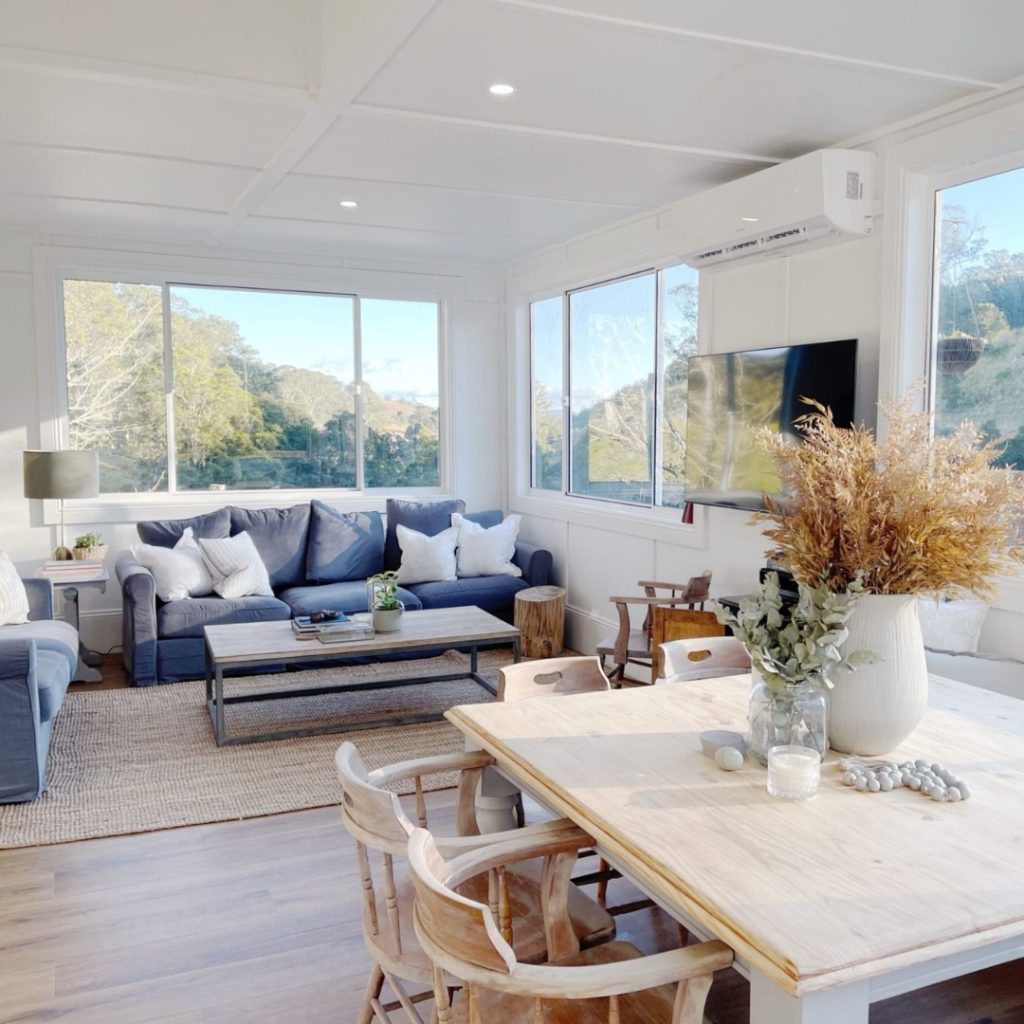An architect, a builder and an energy rater walked into the Home Show to discuss sustainable housing.
In this rare talk, Monica Vandenberg from tiny house enterprise, Nestd, picked the brains of three pre-fab professionals. Nestd is the charity giving 100% profits to Kids Under Cover.

Size doesn’t matter
“How many Hong Kong homes would fit in the average AU home?” Monica asked wistfully. “22.”
We underestimate just how vast our suburban homes are on a global stage. Australia, together with the US, have the biggest, most expensive and inefficient homes in the world. What a disappointing accolade to have in this post-climate change world.
Architects like Grimshaw do a lot of market research before beginning a project. They discovered that the challenges of sustainability and affordability are not going away. Furthermore, they found that small home designs are becoming more intricate as interest in the movement grows. They sought to bring their insights into designed living which covers adaptability and customisation into the tiny world. With the mantra ‘one solution won’t solve everything.’
Benefits of prefab
⏳ Time – 50% quicker
? Quality – Controlled quality in a factory, all measured, no weather problems, experienced trades, cost control
Paying saving through the nose
Monica summed-up Nestd’s mission statement, “as a social enterprise, we don’t want to create homes that cost the earth.”

Analytical minds might correct this affordability statement, saying that a tiny house costs more per square metre than a traditional home. If that’s true, then why isn’t a 30m² seven times cheaper than a 200m² home? The answer lies in the components that make up a property. A tiny house from Nestd contains a kitchenette, shower, toilet, windows, doors, walls, roof and storage. Those materials cost the same price regardless of the space between it. Don’t forget, Nestd homes contain higher quality materials and finishes than an average home, hence the 6+ green star rating.
“[The Peak] was the most exciting project I worked on last year,” exclaimed Tim. “[Tiny houses] are quite an amazing thing. They’re small, but they achieve so much. The issue of affordability comes with not just the purchase price, but also the running costs. We built a beautiful place to live, made with high-quality materials.”
Do you want to save money on shock power bills? Or achieve independence from energy companies? The Peak’s inclined and elevated roof panels can be configured in different orientations and fit 15 300w solar panels. Enough to comfortably live off-grid with a battery system.
A Guide to Living Off The Grid
Energy saved is energy earned
As of 2004, it is a legal requirement to score an energy rating (NatHERS) of at least 6 stars. Though it can get expensive for property developers to achieve six stars. Consequently, every loop-hole in the book has been exploited to avoid pesky energy reviews. Thankfully, the government are tightening the law to stop developers dodging development codes.
Our energy rater Darren has completed over 500,000 ratings, “I think a lot of the time the media and magazines present the type of home we want to live in. We’ve headed down a track where we believe bigger is more beautiful. You can’t put a small home on an expensive block. True sustainability is looking at your true circumstances. Your climate and what you’re going to use this for. Then working from there at the beginning.”
The danger of falling in love with a display home, Darren says, is that you will find yourself ‘trying to put a square peg in a round hole’. Every piece of land carry pros and cons. For example, your property might be in the middle of a high-risk bushfire area. For this reason, it’s essential to work with the elements, not against them. Quite often, developers don’t have the flexibility to design for a specific plot of land. Grimshaw, on the other hand, don’t have those constraints and instead work with energy raters and builders to achieve suitability and sustainability.
Somebody in the crowd raised the topic of insulation. As most Australian homes are poorly insulated, people assume more insulation is better. But sometimes insulation can work against you as Darren describes, “you might live in a hotter climate with cooler nights. And you want your dwelling to cool down at night, ready for the next day.” He described the concept of ‘thermal lag’, “if you have too much insulation, it just holds the heat.”
The Peak, for example, is fully insulated with a six-star energy rating. All the floors, all the walls and all the roof have the same level of insulation. Windows are double glazed, and the roof is angled to face the sun for maximum solar panel production. It can be oriented to maximise sun in the winter for cold climates or block out sun in the summer for hot climates. The Peak is even angled in one direction to give you and your neighbour privacy.
Land of the lost

Aboriginals can teach us a lot about the land, “We cultivated our land, but in a way different from the white man. We endeavoured to live with the land; they seemed to live off it. I was taught to preserve, never to destroy.” Tom Dystra – Aboriginal elder.
Monica is surprised that we still fight our surroundings, “it never ceases to amaze me that when you go to Queensland now, more and more houses are being built with super dark roofs or dark brick. With the Peak, you can change the colour based on the climate.”
Bushfire Attack Level (BAL) ratings are a dirty word for developers, and bush fires are the biggest problem facing rural real estate. For this reason, it’s illegal to build a non-BAL approved property in a high fire risk area. Monica revealed that while Nestd tiny homes are not BAL rated, they’re working on finding the right materials for the job. She said, “the issues, particularly from regional areas, are our fire ratings. Nestd is working to create the Peak in several BAL rating zones.”
Darren weighed in, “It’s much more affordable to work with the environment than to work against it. The BAL rating is something a designer would have to consider, then work with it.”
Councils, who still call tiny homes ‘caravans’, are stricter on small dwellings like Nestd, compared to homes on wheels. Monica explained, “some councils don’t like the fact they are portable homes or that they are on wheels.” In NSW, the rules are more relaxed for garden dwellings. However, it can be difficult in Victoria unless it’s for a dependant. Nestd is advocating for change in legislation and work closely with councils to bring positive change around. After all, sustainable living is high on council agendas all across Australia.
The full talk from the Tiny House Seminar Stage is available below:



